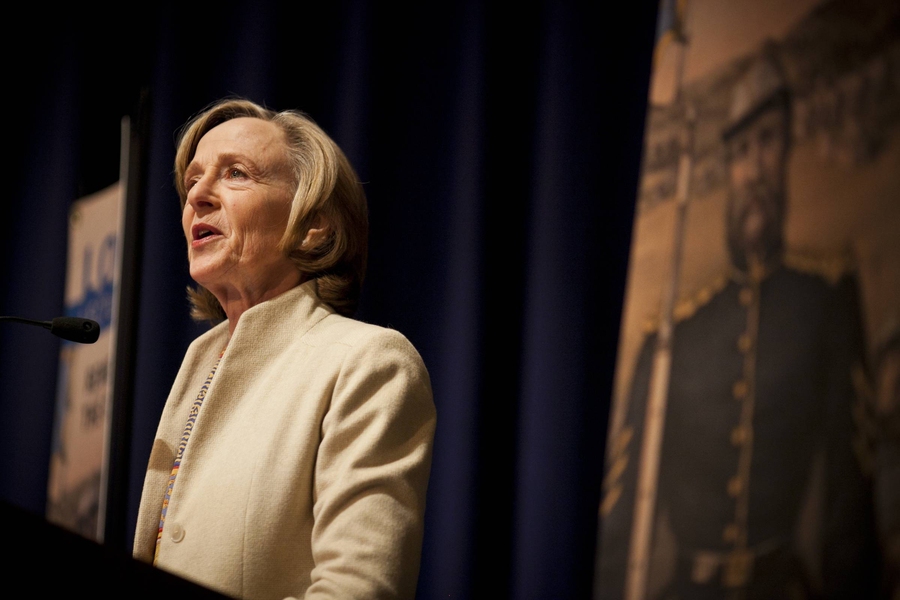On April 10, 1861, the Massachusetts legislature authorized a charter officially creating the Massachusetts Institute of Technology. Two days later, Confederate forces besieged Fort Sumter in South Carolina, signaling the start of the Civil War.
These two events were not merely a coincidence, but “different expressions of the same tectonic forces” acting upon the country, said President Susan Hockfield, crediting the insight to David Mindell, the Frances and David Dibner Professor of the History of Engineering and Manufacturing.
Hockfield spoke Tuesday evening at the Boston Public Library as part of the Lowell Lecture Series commemorating the 150th anniversary of the Civil War. During the hourlong lecture, MIT’s current president looked back at the Institute’s founder and first president, William Barton Rogers, whose vision for a “polytechnic” university — and higher education in general — was shaped by the country’s emerging industrialization, its increasingly divided politics, and the barriers of society and education in the antebellum South.
During the first half of the 19th century, the United States experienced a surge of industrial growth, from Eli Whitney’s cotton gin to the first textile factories in Massachusetts and the invention of the sewing machine — the news of which, Hockfield noted, was conveyed via another milestone innovation: the telegraph. As the country approached 1850, she said, “volatile national arguments over states’ rights came to dominate the nation’s dialogue from Missouri to Massachusetts.”
Rogers, born in Philadelphia in 1804, spent most of his life in Virginia — “a crucial stress point in the nation’s political geography,” Hockfield said. Rogers’ father, trained as a physician and scientist, instilled in his four sons a deep appreciation for mathematics and science. When his father died of malaria in 1828, Rogers assumed his professorship at Virginia’s College of William and Mary. Seven years later, he moved to the University of Virginia, where he taught for the next two decades.
However, Hockfield said, Rogers felt stifled by the isolation of rural college life and the entrenched hierarchy of Southern society.
“Rogers was an intensely upright person and found the reality and politics of slavery appalling,” she said. “As for the students, he found them on the whole a less-than-inspiring lot … vain, violent, drunken, entitled, prone to riot, they were the scions of Virginia’s plantations and they, in his mind, had made a mockery of Jefferson’s academic paradise.”
Hockfield noted that Rogers was also forced to confront the damaging ways that politics could override good science. He was selected by the Virginia legislature to conduct a geologic survey of the state — a scientific mission that Rogers relished. However, politics soon got in the way of scientific results: One side of the legislature pushed Rogers to emphasize the potential for industrial coal mining, while “the slave-owning eastern planters” wanted Rogers to search out sources of gypsum to revitalize their depleted farmlands. Rogers spent year after year lobbying for funds to continue the survey — a skill that would later prove useful in creating MIT.
Moving North
The idea for a polytechnic university had been brewing in Rogers’ mind for decades, as he observed emerging signs of industrialization. In her talk, Hockfield spoke of the nation’s mid-19th-century vacillation over the purpose of higher education, “alternately reflecting and rejecting the reality of industrialization already shaping America’s everyday life and America’s economic prospects.”
“Unlike many of his peers, Rogers had immense respect for what that labor could achieve, if powered by the right scientific education,” she said. “Unfortunately, in the antebellum era, America’s scientific elite had little interest in practical affairs. So as a result, across this still-young nation, engineers and architects, mechanics and farmers, chemists and manufacturers were held back by their meager grasp of the science of materials and forces they worked with.”
Rogers’ brother Henry had already moved north to Boston, and wrote often about the city and its intellectual opportunities. At the time, Boston was a hotbed of daring new ideas, from abolition and free, universal common schools to industrial inventions of every kind. Rogers and his wife, Emma, a native Bostonian, soon moved there themselves, where Rogers refined his plan for an educational institute devoted to making science more useful and the “useful arts” — technology and engineering — more scientific. In the summer of 1860, Hockfield said, Rogers spent most of his time speaking, writing and persuading potential supporters — in effect, lobbying for his cause.
Following the state legislature’s granting of MIT’s charter and several years of frantic fundraising, the Institute began construction of its first building in 1863, on a site in Boston’s then-new Back Bay neighborhood. On Feb. 20, 1865, six weeks after General Robert E. Lee surrendered his forces at the Battle of Appomattox, MIT admitted its first 15 students.
Since then, Hockfield noted, research universities including MIT have made significant contributions to the country’s economic and industrial growth. Looking ahead, she observed that MIT’s challenges today are similar to those it faced in its earliest days: A century and a half ago, William Barton Rogers wanted to help industrialization flourish in the country. Today, with a shaky economy and high unemployment, Hockfield sees the same need.
“As a nation, we cannot remain economically strong, we can’t continue to be intellectually vibrant, if we can’t make the products we invent here,” she said. “Rogers founded MIT in order to accelerate the industrialization of America — and hey, we’re working on the same project today. It changes era by era, but it’s a place where I think MIT has served the nation well.”
President Susan Hockfield speaks on the struggle for America’s future — then and now.
Publication Date:

Caption:
MIT President Susan Hockfield delivers a lecture on Tuesday evening at the Boston Public Library as part of the Lowell Lecture Series, which commemorates the 150th anniversary of the Civil War.
Credits:
Photo: Dominick Reuter

Caption:
MIT President Susan Hockfield discusses the intertwined history of MIT and the Civil War.
Credits:
Photo: Dominick Reuter





